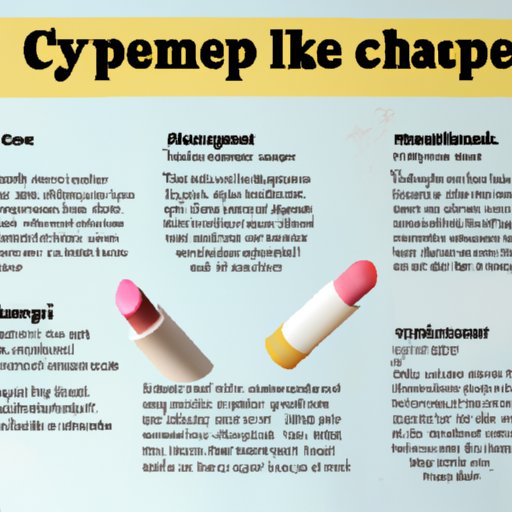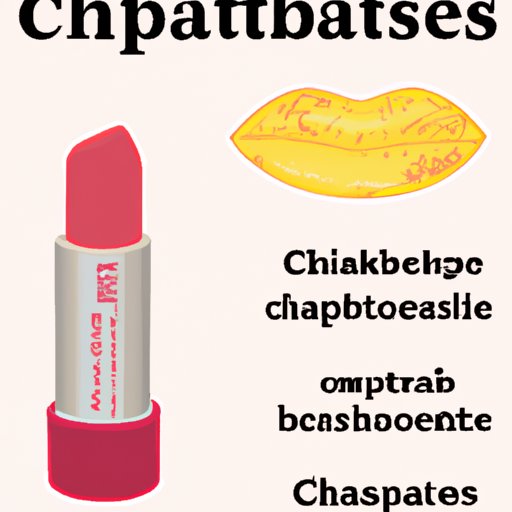Introduction
Chapstick is a popular lip balm used to protect and nourish dry and chapped lips. It is typically made with a blend of waxes, oils, and emollients that help to moisturize and soften the skin on the lips. This article will explore the science behind chapstick and explain how it works to protect and nourish lips. It will also look at the chemistry of chapstick and the primary ingredients used to make it so effective. Finally, it will provide an overview of the different types of chapstick available and discuss the pros and cons of using it.
Exploring the Science Behind Chapstick: How Does It Work?
Chapstick works by forming a barrier on the surface of the lips to prevent moisture from escaping. This barrier helps to keep lips hydrated and prevents them from becoming dry and cracked. In addition to forming a protective barrier, chapstick also contains ingredients that work to nourish and moisturize the lips. These ingredients include waxes, oils, and emollients that help to soften and soothe the skin on the lips.
The Chemistry of Chapstick: What Makes It So Effective?
Chapstick is made up of a combination of waxes, oils, and emollients that work together to form a protective barrier and nourish the lips. Common ingredients found in chapstick include beeswax, petroleum jelly, lanolin, cocoa butter, and various essential oils. The waxes help to form a protective barrier on the lips, while the oils and emollients work to soften and moisturize the skin. Together, these ingredients help to protect and nourish the lips.
Understanding the Ingredients of Chapstick and How They Nourish Your Lips
Beeswax is a common ingredient found in chapstick. It forms a protective barrier on the lips that helps to lock in moisture and prevent it from evaporating. Petroleum jelly is another common ingredient that helps to soften and soothe the skin on the lips. Lanolin is a waxy substance derived from sheep’s wool that helps to lock in moisture and keep lips hydrated. Cocoa butter is a rich emollient that helps to nourish and condition the lips. Finally, various essential oils are often added to chapstick to add pleasant scents and flavors.
An In-Depth Look at the Benefits of Using Chapstick
Chapstick can provide a variety of benefits for the lips. It can help to lock in moisture and prevent lips from becoming dry and cracked. It can also help to nourish and condition the lips, making them softer and more supple. Additionally, chapstick can help to protect the lips from environmental factors such as wind and cold temperatures. Finally, many varieties of chapstick contain SPF protection to help shield the lips from sun damage.

A Guide to Different Types of Chapstick and Their Benefits
There are a variety of different types of chapstick available. Some types are designed specifically for dry or chapped lips, while others are designed to provide extra moisture or nourishment. There are also lip balms that contain SPF protection to help shield the lips from the sun. Similarly, there are lip balms that contain natural ingredients such as shea butter or coconut oil to help nourish and protect the lips.
The Pros and Cons of Chapstick: Is It Right for You?
Chapstick can be beneficial for those with dry or chapped lips. It can help to lock in moisture and nourish the lips, keeping them soft and healthy. However, chapstick is not suitable for everyone. Those with sensitive skin or allergies may find that chapstick irritates their skin or causes an allergic reaction. Additionally, some people may find that chapstick does not provide enough moisture or nourishment for their lips. Ultimately, it is important to consider your individual needs before choosing a chapstick.
Conclusion
In conclusion, this article has explored the science and benefits of chapstick. It has explained how chapstick works to protect and nourish lips, as well as the chemistry behind its effectiveness. It has also looked at the different types of chapstick available and their associated benefits. Finally, it has discussed the pros and cons of using chapstick and how to determine if it is right for you. For further research, it is recommended to consult with a dermatologist or pharmacist to find the best type of chapstick for your individual needs.
(Note: Is this article not meeting your expectations? Do you have knowledge or insights to share? Unlock new opportunities and expand your reach by joining our authors team. Click Registration to join us and share your expertise with our readers.)
